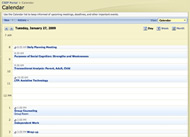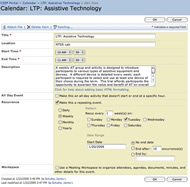Jamie L. Schutte, MS1 , Michael Pramuka, PhD1 , Michael Mccue, PhD1 , Andrea D. Fairman1 , MOT, Andi Saptono2 , MS, Bambang Parmanto, PhD2
1 Department of Rehabilitation Science and Technology
2 Department of Health Information Management University of Pittsburgh, Pittsburgh, PA 15260
ABSTRACT
Using web-based technology to build information management infrastructure to support telerehabilitation (TR) applications can potentially improve the quality and consistency of services provided in community-based rehabilitation. A methodology for developing an information management infrastructure to support TR, the PITT model, has been adapted to fit the needs of the Cognitive Skills Enhancement Program (CSEP), a community-based pre-vocational cognitive rehabilitation program. A web-based Portal that includes participant information and progress reports, an interactive calendar, session and activity information, and methods to improve the quality of staff communication, has been created and implemented. This Portal is user-friendly, inexpensive, and has potential to improve the quality of services provided in many community-based rehabilitation programs.
KEYWORDS
Telerehabilitation, information technology, web-based portal, community-based rehabilitation
BACKGROUND
Telerehabilitation (TR) has been defined as the application of telecommunication technology for supporting rehabilitation services (1). TR is an emerging field that is rapidly growing to become a significant segment of telemedicine and e-health. The advances of Internet technologies and the availability of broadband connections have expanded TR applications that were previously too complicated or expensive to deliver. The use of TR opens up opportunities for underserved areas, such as rural communities, to access advanced rehabilitation services that are otherwise only available in metropolitan areas. Tapping into the expertise of metropolitan area centers also allows rural clinics to expand their services to include specialized services.
The nature of the rehabilitation services determines the necessary telecommunication technology and informatics infrastructures. Community-based rehabilitation processes typically need continuous monitoring of clients’ goals, setbacks, and progress, as well as effective and confidential ways of communicating this information to a variety of professionals. (This is in contrast to typical telemedicine services that generally involve a short, intensive session between a clinician and a patient.) In addition, many community-based programs would benefit from accessing the clinical knowledge of experts who are not full-time staff members due to distance or budgetary concerns.
The University of Pittsburgh’s Department of Rehabilitation Science and Technology (RST) conducts clinical, academic, and research activities in its Johnstown, PA location at Hiram G. Andrews Center (HGAC). HGAC is a state-operated vocational rehabilitation facility, primarily serving consumers of Pennsylvania’s Office of Vocational Rehabilitation (OVR). The Cognitive Skills Enhancement Program (CSEP) is operated by RST but is integrated into the larger service structure of HGAC. It is a stand-alone, 15-week, Monday through Friday, pre-vocational training program specifically designed for individuals with cognitive disabilities, in operation since 2005. Each term, CSEP accepts approximately 15 participants. Operating in conjunction with CSEP is the Learning Technology Program (LTP), which is housed in the Center for Assistive Rehabilitative Technologies (CART).
CSEP staff includes, from RST, a full-time Program Director, four part-time Pre-Doctoral students (Rehabilitation Specialists), two part-time LTP Assistive Technologists, and two consulting Neuropsychologists. There are also various HGAC employees who provide services for CSEP participants, including a group counselor, OVR counselors located at HGAC, mental health counselors, and a vocational counselor.
In order to provide quality services to CSEP participants, CSEP staff members must have access to up-to-date information, including individual participants’ histories, goals, strategies, accommodations, and assistive technology currently being evaluated, current issues or difficulties, and information on the structure and progress of the group as they move through various cognitive, social, and vocational sessions and activities. Regular staff meetings, trainings, and supervisions are also important to ensure the quality of services being provided. Coordinating and organizing across employers (University of Pittsburgh and HGAC) and geographical locations (Pittsburgh and Johnstown) makes communication a daunting task. One way of effectively managing information is through TR technologies.
CLINICAL OBJECTIVE
CSEP was struggling with issues related to paper documentation, included but not limited to: client files that could not be transported for review by University of Pittsburgh Neuropsychologists, and an unwieldy number of session and activity notes, directions, and handouts that easily became disorganized and thus difficult to locate or update. The objective was to develop a web-based Portal that would support a variety of clinical activities in order to increase efficiency and improve clinical practices. The CSEP Portal needed to include methods of gathering and updating individual participants’ information and progress, planning and updating the group schedule of sessions and activities, organizing Learning Technologies Program (LTP) daily notes and reports, documenting intake/referral screening information, storing program evaluation/research data, and improving methods of staff communication during meetings, trainings, and supervisions. Ideally, this Portal could be modified to fit the needs of other community-based rehabilitation programs.
METHOD
The PITT model of Information Management Infrastructure was developed at the University of Pittsburgh’s Rehabilitation Engineering and Research Center on Telerehabilitation (RERC-TR). The PITT model is an information management infrastructure designed to support TR applications. The infrastructure was developed through a design process that focused on accessibility, openness, extensibility, cost-effectiveness, and security (2). This model was customized to address various TR needs specific to CSEP.
RESULTS
The final product, the CSEP Portal, is accessible from any computer with an Internet connection. Encompassing all aspects of the PITT model is the security of the infrastructure. The Portal has been built to comply with common security policies, such as encryption of data, requiring access information, and limiting access to rightful persons. Staff logs in with a University of Pittsburgh username and password. University of Pittsburgh staff have full access; HGAC staff have limited access based on the specific information their job requires them to access.
Following is a more detailed explanation of several of the Portal’s key features.
Calendar
The calendar has monthly, weekly, and daily views. Sessions and activities can be scheduled at any time, by any staff member. Part-time staff can view what was covered during days and sessions when they were not present; likewise, staff physically located at the University of Pittsburgh can monitor group progress. If a session or activity was not completed on the day it was scheduled, it can easily be bumped to the next day.
When staff clicks on an event in the calendar, a more detailed description is displayed, including a blurb about the session, necessary attachments, and directions regarding where to locate more information (i.e., the CSEP Sessions/Activities folder.)
CSEP Sessions/Activities
This folder houses information for group sessions and activities organized by topic (e.g., memory, attention, problem solving). CSEP staff can access descriptions of activities and documents necessary (e.g., handouts) to complete the activity. All sessions/activities on the calendar correspond with folders in CSEP Sessions/Activities.
CSEP Tier I
Tier I consists of participants who are currently participating in the full-time term-long CSEP. In this folder, narratives of all participants are stored. Narratives include a participant photograph, demographic information, OVR counselor contact information, and participant goals, diagnoses, medications, educational and work history, intellectual assessment results, etc. During team meetings or Pre-Doc supervisions, even when held via videoconference, all staff members have access to pertinent participant information.
The Tier I folder also houses individual client notes taken by the on-site CSEP staff. Daily performance in sessions (e.g., participation, performance on tests and other activities) is documented. Evaluations, such as weekly progress checklists and mentorship evaluations, are also stored in participants’ individual files.
Learning Technologies Program
LTP uses the Portal to document and organize their billing database, daily notes, referral database, and documents. Reports are automatically generated to send to CART. In addition, CSEP clinicians can use the Portal to make referrals for clients to be evaluated for AT and monitor client use of AT on an ongoing basis.
Intake/Referral Screening
CSEP staff interview and review files of potential CSEP participants who have been referred either by their OVR counselor or the HGAC vocational counselor. In this database, staff is able to track the client’s demographic information, if the client was seen by a University of Pittsburgh Neuropsychologist, the interview and file review date, additional information requested, if the client meets acceptance criteria, contraindications, and the acceptance decision.
Program Eval/Research Data
Several assessments are completed pre-, mid-, and post-term. All assessments are stored in a database so participant progress can be monitored and program evaluation and research data can be easily collected.
Other
Other features of the Portal include CSEP Tier II and III folders; libraries of Form Templates, Resources, Shared Documents, Links, and Pictures; a WAIS Testing folder where medical records and a tracking database are accessible to the University of Pittsburgh Neuropsychologists; Announcements, where posted messages will be available on the home page to quickly inform all staff; and a Team Discussion list, where newsgroup-style message boards can be used to hold discussions on topics relevant to the team.
DISCUSSION
The Portal has recently (Spring 2009) been implemented. Given experiences and feedback thus far, the authors anticipate it will provide functional benefits, including improved communication and increased efficiency, compared to the old system of paper records and a written curriculum. The creation of a customized, user-friendly Portal has the potential to improve standard operating procedures in a variety of different community-based clinical settings.
REFERENCES
- Russell, T. G. (2007). Physical rehabilitation using telemedicine. Journal of Telemedicine and Telecare, 13 (5), 217-220.
- Parmanto, B., Saptono, A., Sugiantara, W., Brienza, D., & Nnaji, B. (2006, June). Information Technology Infrastructure for Supporting Telerehabilitation. Poster session presented at the RESNA Conference, Atlanta, GA.
ACKNOWLEDGEMENTS
Development of this system was funded by the National Institute on Disability and Rehabilitation Research (NIDRR) grant #H133E040012; an outcome of Rehabilitation Engineering Research Center (RERC) on Telerehabilitation.
This system was created in collaboration with Hiram G. Andrews Center, state-operated vocational rehabilitation facility, located in Johnstown, PA.
Author Contact Information:
Jamie Schutte, MS, University of Pittsburgh, Atwood and Sennott Streets, Pittsburgh, PA 15260, Office Phone (412) 383-6884 EMAIL: jcs85@pitt.edu


